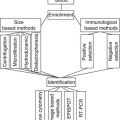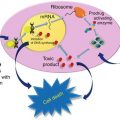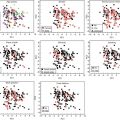Drug class
Agents
Alkylating agents
Cyclophosphamide
Antimetabolites
5-Fluouracil (5-FU), methotrexate, capecitabine, gemcitabine
Platinum salts
Cisplatin, carboplatin, oxaliplatin
Anthracyclines
Daunorubicin, doxorubicin, idarubicin, epirubicin, mitoxantrone
Topoisomerase I inhibitors
Irinotecan
Topoisomerase II inhibitors
Etoposide
Vinca alkaloids
Vinorelbine
Taxanes
Docetaxel, paclitaxel
Epothilones
Ixabepilone
In the metastatic setting, based on National Comprehensive Cancer Network (NCCN) guidelines, systemic chemotherapy is recommended for patients with symptomatic visceral involvement due to metastatic disease such as the liver, lung, and bone marrow. However, toxicity remains a limitation of breast cancer treatment, as shown in Table 24.2.
Table 24.2
Breast cancer chemotherapy and systemic toxicities
Agent | Main toxicities |
|---|---|
Anthracyclines | Cardiotoxicity, myelosuppression |
Capecitabine | Hyperbilirubinemia, diarrhea, hand-foot syndrome |
Taxanes | Neurotoxicity, neutropenia |
Epothilones | Neutropenia, peripheral neuropathy |
Anthracyclines
Anthracyclines include daunorubicin, doxorubicin, idarubicin, epirubicin, and mitoxantrone. The anthracyclines commonly used in treatment of breast cancer are either epirubicin or doxorubicin. Epirubicin is an epimer of doxorubicin with an important role in the chemotherapy treatment of both early and metastatic breast cancer [5]. The efficacy of epirubicin is similar to doxorubicin, while epirubicin has a different toxicity profile, particularly in regard to cardiotoxicity. The major side effects of anthracyclines are cardiotoxicity and myelosuppression. Doxorubicin is the most extensively studied anthracycline regarding cardiotoxicity [6]. Reported rare cardiac complications of doxorubicin treatment include acute reversible arrhythmias, subacute toxic myocarditis, and pericarditis. The most thoroughly evaluated cardiotoxicity of doxorubicin is cumulative progressive damage that leads to clinical events ranging from light reduction of left ventricular ejection fraction to irreversible life-threatening congestive cardiac failure [6]. Congestive cardiac failure due to anthracycline appears early, i.e., several days to months after treatment, peaking at 3 months following the last dose, or late appearing up to 10–12 years after the last anthracycline dose. Risk factors for anthracycline cardiotoxicity include cumulative dose (the strongest risk factor), age, prior irradiation, concomitant administration of other drugs, and previous history of drug disease. A maximum cumulative tolerant dose of 450–500 mg/m2 has been recommended. Since the maximum cumulative dose in most breast cancer chemotherapeutic regimens ranges from 240 to 300 mg/m2, breast cancer patients seem not to be affected by doxorubicin cardiotoxicity. Liposomal doxorubicin has been shown to have less cardiotoxicity. Epirubicin has been reported to have lower cardiotoxicity than doxorubicin, and a cumulative tolerable dose of 900–1,000 mg/m2 has been suggested [6].
Epirubicin has been incorporated into most of the anthracycline-containing chemotherapy combinations in well-conducted clinical trials involving large numbers of patients. It has also been investigated in studies involving the administration of epirubicin in dose-dense chemotherapy schedules. Short-term follow-up of dose-dense clinical trials demonstrated safety comparable to that of doxorubicin.
Capecitabine
Capecitabine is an oral prodrug of 5′-deoxy-5-fluorouridine (5′-DFUR). It is converted to 5-FU preferentially in tumor tissue through exploitation of high intratumoral concentrations of thymidine phosphorylase. After oral administration, capecitabine passes intact through the intestine, thus avoiding the direct release of 5-FU within the gastrointestinal tract. Capecitabine subsequently undergoes a three-step enzymatic conversion, the final stage of which relies on thymidine phosphorylase. This enzyme is overexpressed in a proportion of tumor tissues compared with normal tissues, thus resulting in the generation of 5-FU preferentially at the tumor site and decreasing systemic exposure to 5-FU. Bioavailability after oral administration is close to 100 % [7].
Capecitabine is effective and adequately tolerated, both as a monotherapy and as an addition to intravenous polychemotherapeutic to treat several types of cancers. Furthermore, the combination of capecitabine with taxanes is appropriate, because taxanes show synergistic effects with capecitabine. Capecitabine is effective for salvage treatment of patients with metastatic breast cancer. Thus, according to the Breast Cancer Guidelines Committee of the NCCN, capecitabine/docetaxel is considered a preferred combined chemotherapy regimen for recurrent or metastatic breast cancer after failure of anthracycline-based chemotherapy. The drug has also been approved for use as a single agent in metastatic breast cancer patients who are resistant to both anthracycline- and paclitaxel-based regimens or in whom further anthracycline treatment is contraindicated.
In addition, capecitabine has also been used in neoadjuvant breast cancer chemotherapy, with conflicting results. A very recently published meta-analysis including five trials of 3,257 patients with early or operable breast cancer without distant metastasis, treated in the neoadjuvant setting with capecitabine and anthracycline- and/or taxane-based therapy, found that adding capecitabine to neoadjuvant chemotherapy regimens is unlikely to improve outcomes in breast cancer patients without distant metastasis [8].
The most common dose-limiting adverse effects associated with capecitabine monotherapy are hyperbilirubinemia, diarrhea, and hand-foot syndrome. Myelosuppression, fatigue and weakness, abdominal pain, and nausea have also been reported. The dose of capecitabine approved by the US Food and Drug Administration (FDA) for both metastatic colorectal and breast cancer is 1,250 mg/m2 given orally twice per day, usually separated by 12 h for the first 2 weeks of every 3-week cycle.
Taxanes
The taxanes docetaxel and paclitaxel were initially introduced in metastatic breast cancer treatment. The taxanes exert their cytotoxicity through tubulin stabilization and cell cycle arrest [9]. They have also been shown to promote apoptosis, inhibit angiogenesis, and induce genes that mediate diverse cellular processes. Although in general the mode of action is similar, docetaxel has a longer plasma half-life and longer intracellular retention, in addition to greater potency in promotion of tubulin assembly and microtubule stabilization compared with paclitaxel. The major toxicities include neurotoxicity for paclitaxel, peripheral neuropathy with docetaxel, and neutropenia, which appears to be more prevalent with docetaxel than with paclitaxel. Other important toxicities include hypersensitivity reactions for paclitaxel and fluid retention and gastroenteric toxicity for docetaxel. In addition, asthenia, alopecia, and mouth ulcers are common adverse events with both agents. Taxane resistance, defined as progression while on therapy or ≤12 months in the adjuvant setting or 4 months in the metastatic setting, is a common problem.
Epothilones
Epothilones are cytotoxic macrolides with a similar mechanism of action to paclitaxel but with the potential advantage of activity in taxane-resistant settings in preclinical models. The antineoplastic activity of epothilones has been attributed to stabilization of microtubules, which results in mitotic arrest at the G2/M transition.
Ixabepilone is a semisynthetic analog of epothilone B designed to optimize the characteristics of its natural precursor. It is characterized by low susceptibility to common mechanisms of tumor resistance, including those mediated by the multidrug resistance protein, P-glycoprotein [10, 11]. In addition, microtubule-stabilizing agents such as ixabepilone prolong activation of the spindle assembly checkpoint, which may promote cancer cell death in mitosis or following mitotic exit. Furthermore, epothilone B analog, ixabepilone, has also been shown to induce apoptosis via a Bcl-2-suppressible pathway that controls a conformational change of the proapoptotic Bax protein. Ixabepilone is metabolized in the liver, and caution should be used when considering patients with liver impairment for therapy with this agent. Ixabepilone exposure is greater in patients with hepatic impairment and those receiving concomitant strong cytochrome P-450 CYP3A4 inhibitors.
In October 2007, ixabepilone was approved by the FDA for the treatment of locally advanced and metastatic breast cancer. Ixabepilone is indicated as monotherapy for the treatment of metastatic or locally advanced breast cancer in patients whose tumors are resistant or refractory to anthracyclines, taxanes, and capecitabine. Ixabepilone is also indicated in combination with capecitabine for the treatment of patients with metastatic or locally advanced breast cancer resistant to treatment with an anthracycline and a taxane or whose cancer is taxane resistant and for whom further anthracycline therapy is contraindicated.
Hematologic toxicities associated with ixabepilone use include neutropenia, leukopenia, anemia, and thrombocytopenia. Neutropenia is the most common toxicity of ixabepilone monotherapy. Dose reductions are recommended in patients who experience severe neutropenia or thrombocytopenia. Ixabepilone is contraindicated in patients with a neutrophil count <1,500 cells/mm3. Symptoms of peripheral neuropathy such as burning sensation, hyperesthesia, hypoesthesia, paresthesia, discomfort, or neuropathic pain have been reported in clinical trials of ixabepilone. Hypersensitivity reactions to ixabepilone treatment have also been reported. Although ixabepilone is not considered cardiotoxic, caution is recommended in patients with a history of cardiac disease, and ixabepilone should be discontinued in patients who develop cardiac ischemia or impaired cardiac function while on therapy.
Chemotherapy of Metastatic Breast Cancer
Anthracycline- and taxane-based regimens are recommended as first-line treatment of metastatic breast cancer (Table 24.3). However, there are few options for the treatment of patients with anthracycline- and taxane-resistant or taxane-refractory metastatic breast cancer [12]. Single-agent capecitabine is approved for the treatment of patients after failure of anthracyclines and taxanes. Ixabepilone has demonstrated efficacy in patients with metastatic breast cancer resistant to multiple chemotherapeutic agents and is the only agent approved by the FDA as a monotherapy for anthracycline-, taxane-, and capecitabine-resistant metastatic breast cancer [12].
Table 24.3
Metastatic breast cancer—possible chemotherapeutic options
Combined chemotherapy | Monochemotherapy |
|---|---|
Taxanes–anthracyclines | Anthracyclines |
Oxaliplatin–gemcitabine | Taxanes |
Docetaxel–vinorelbine | Eribulin |
Docetaxel–capecitabine | Vinorelbine |
Vinorelbine–capecitabine | Capecitabine |
Paclitaxel–gemcitabine | Platinum salts |
Cyclophosphamide | |
5-FU |
Endocrine Treatment
Endocrine treatment is the oldest targeted treatment of breast cancer. Selective estrogen receptor modulators (SERMs), such as tamoxifen, aromatase inhibitors, and GnRH agonists, are the drugs of choice. GnRH agonists suppress ovarian function, inducing a menopause-like condition in premenopausal women [13]. Fulvestrant and progestins are used in the treatment of metastatic breast cancer (Table 24.4).
Table 24.4
Breast cancer hormonotherapy—drug classes other than aromatase inhibitors
Drug class | Agent | Indication |
|---|---|---|
SERM | Tamoxifen | Breast cancer adjuvant and metastatic, male breast cancer, chemoprophylaxis of high-risk women |
SERD | Fulvestrant | Metastatic breast cancer |
LHRH agonists | Goserelin, triptorelin | Premenopausal women with hormone-positive breast cancer |
Progestins | Megestrol acetate, medroxyprogesterone acetate | Metastatic breast cancer |
Selective Estrogen Receptor Modulators (SERMS)
SERMS are a structurally diverse group of compounds that bind to estrogen α (ERα) and estrogen β (ERβ) receptors and produce estrogen agonist effects in some tissues and estrogen antagonist effects in others. The tissue specificity of SERMS is determined in part by the formation of estrogen receptor-SERM complexes that vary in their ability to activate genes when bound to Erα or ERβ.
Tamoxifen, a synthetic nonsteroidal antiestrogen, is a classical partial agonist and exhibits both species and tissues specificity for inducing either an agonist or antagonist response. In the mouse, tamoxifen is an agonist. In rats and humans, it exhibits partial agonism, i.e., producing antagonist effects in the breast but agonist effects in the vagina and endometrium [14]. Long-term tamoxifen use is associated with a reduced incidence of contralateral breast cancer (antagonist), a reduced incidence of primary breast cancer in high-risk women (antagonist), maintenance of bone density (agonist), and increased risk of endometrial carcinomas (agonist).
The parent drug has weak affinity for the estrogen receptors but undergoes excessive biotransformation catalyzed by phase I and II enzymes into active and inactive metabolites. N-dimethyl-tamoxifen is the primary metabolite formed via CYP3A4/5. N-dimethyl-tamoxifen is a weak antiestrogen, but it is subsequently metabolized into a-hydroxy-tamoxifen, N-didesmethyl-tamoxifen, and 4-hydroxy-N-desmethyl-tamoxifen (known as endoxifen). 4-hydroxy-tamoxifen is a minor primary metabolite whose production is catalyzed by multiple enzymes including CYP2D6. Endoxifen and 4-hydroxy-tamoxifen each have at least tenfold higher affinity for estrogen receptors than tamoxifen and are associated with equivalent antiestrogenic potency. In patients receiving chronic tamoxifen therapy, endoxifen is found in serum concentration 6- to 12-fold higher than 4-hydroxy-tamoxifen. Thus, it is suggested that endoxifen is the most important metabolite required for tamoxifen treatment. Tamoxifen administered as a single oral dose of 20 mg is rapidly absorbed and reaches its peak concentration in about 5 h. The terminal elimination half-life is about 5–7 days. Steady-state concentrations in plasma are reached after 4 weeks of tamoxifen treatment. About 65 % of the administered dose of tamoxifen is excreted over 2 weeks, primarily by fecal excretion.
Tamoxifen is approved for the adjuvant and metastatic treatment of estrogen receptor-positive breast cancer. Currently, tamoxifen is the preferred treatment for premenopausal women with estrogen receptor-positive breast cancer. In addition, postmenopausal women with intolerance to aromatase inhibitors could change to tamoxifen after at least 2 years of treatment with aromatase inhibitors. Furthermore, tamoxifen is approved for the hormonal treatment of male breast cancer. Finally, tamoxifen is the only drug approved for breast cancer chemoprophylaxis of high-risk women.
Clinical trials in women older than 50 years diagnosed with breast cancer have shown treatment benefit in overall survival. In women undergoing surgery for node-negative breast cancer, tamoxifen therapy was associated with significant prolongation of disease-free survival in comparison with the placebo-treated women. Tamoxifen reduced the rate of treatment failure at local and distant sites, tumors in the opposite breast, and the incidence of tumor recurrence after lumpectomy and radiation. The Early Breast Cancer Trialist Collaborative Group performed a meta-analysis of 55 clinical trials including more than 37,000 women and concluded that tamoxifen therapy was associated with a significant reduction in recurrence (26 %) and death (14 %) compared with placebo after a median follow-up of 10 years. Additionally, it was shown that women with estrogen receptor-positive tumors and those treated for at least 5 years had substantially greater benefit than the women with estrogen receptor-negative tumors or those treated for a time period shorter than 5 years. Specifically, in women with estrogen receptor-positive disease, 5 years of tamoxifen reduced the annual breast cancer death rate by 31 % irrespective of age, administration of adjuvant chemotherapy, progesterone receptor status, or other tumor characteristics [14–16].
The efficacy of tamoxifen treatment in estrogen receptor-negative tumors remains controversial. Regarding the effect of the duration of tamoxifen therapy on recurrence and death, it has been demonstrated that in women with estrogen receptor-positive tumors, 5 years of adjuvant tamoxifen treatment was superior than 1 or 2 years [15]. Furthermore, it has been shown that tamoxifen therapy for a period greater than 5 years confers no additional benefit [15].
In addition, tamoxifen has been proved effective in the treatment of metastatic breast cancer. Tamoxifen still remains the initial treatment of choice for women who present with relapse of disease ≥6 months after discontinuation of tamoxifen treatment.
On the other hand, tamoxifen treatment has been associated with a number of benign lesions in the endometrium, including endometrial thickening, endometrial polyps, and endometrial cystic atrophy, as noted in Table 24.5. However, the most serious uterine condition associated with tamoxifen use is endometrial cancer, which is increased by twofold to fourfold relative to placebo. The most common adverse effects of tamoxifen are menopausal symptoms including hot flashes and atrophic vaginitis. Vaginal discharge and irregular menses have also been reported in postmenopausal women. In addition, retinopathy has been reported in women taking higher doses of tamoxifen. However, vision-threatening ocular toxicity has rarely been reported. Tamoxifen has been associated with a slightly increased incidence of cataracts. Tamoxifen increases the risk of thromboembolic events, including deep venous thrombosis and pulmonary embolism. Estimates of the risk ratio (RR) of thromboembolic events range from 1.3 to 7.0 [15, 17].
Table 24.5
Breast cancer hormonal therapy—adverse events
Tamoxifen | Aromatase inhibitors |
|---|---|
Thromboembolic events | Bone fractures |
Benign endometrial lesions | Arthralgias |
Endometrial cancer | Hypercholesterolemia |
Retinopathy–cataracts | Cardiovascular events |
Aromatase Inhibitors
Aromatase inhibitors block the aromatase enzyme in the final step of estrogen synthesis, thus lowering circulating estrogen levels and depriving the estrogen receptor of its substrate. The suppression of circulating estrogen is profound, approximately 95–98 %, with all the third-generation aromatase inhibitors. Aromatase inhibitors are classified as nonsteroidal, such as anastrozole and letrozole (reversible type II), and steroidal aromatase inhibitors (irreversible type I), such as exemestane (see Table 24.6). Aromatase inhibitors are now part of the standard treatment for most postmenopausal women with estrogen receptor (ER)- and/or progesterone receptor (PgR)-positive invasive breast cancer. These agents are given either alone or in sequence before or after tamoxifen. Postmenopausal women with estrogen receptor-positive breast cancer should be treated with aromatase inhibitors for 5 years. For perimenopausal women who have been initiated with tamoxifen, switching to an aromatase inhibitor to complete 5 years of treatment is recommended after 2–3 years of tamoxifen treatment, in case of definitive amenorrhea. In addition, according to the results of the extended adjuvant therapy studies in the postmenopausal women after completion of 5 years of standard tamoxifen treatment, continuation with aromatase inhibitors for at least 2–5 years could be an option, especially for node-positive women or for women with risk prognostic factors. Aromatase inhibitors are contraindicated in premenopausal and perimenopausal women [16].
Table 24.6
Aromatase inhibitors
Drug class | Agents | Indication |
|---|---|---|
1st class | Aminoglutethimide | Metastatic breast cancer |
2nd class | Fadrozole, rogletimide, formestane | Metastatic breast cancer
Stay updated, free articles. Join our Telegram channel
Full access? Get Clinical Tree
 Get Clinical Tree app for offline access
Get Clinical Tree app for offline access

|



